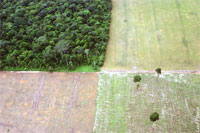Claire Martin, Programme Coordinator in Transparency International’s Forest Governance Integrity Programme, introduces a project that reduces corruption risks in saving our forests.
As a child growing up, one of the high-points of my year was the spirited wars I would wage against my friends each September, armed with just a horse chestnut, pierced through the middle and attached to a piece of twine. On a recent visit home, I was therefore horrified to hear about a “bleeding canker” that was attacking the tree. Although it is still too early to know the exact cause in this case, there is one blight to trees that we do have significant information on and which has much more far-reaching and serious consequences for millions of people around the world. Another, less documented disease relentlessly attacking our forests is corruption.

photo: flickr/leoffreitas
It is only recently that the value of retaining our forests to regulate carbon dioxide levels in the atmosphere been recognized (deforestation is estimated to be responsible for 15 percent of global warming pollution). This means that for centuries, the main value of forests – the lungs of our planet – has been placed in their destruction. As pointed out in the Global Corruption Report on Climate Change, around 13 million hectares of forest were converted to other uses or lost through natural causes each year in the last decade.
Corruption, however, is a barrier to leaving this old approach behind. Indeed, my colleague Michel Gary, recently blogged about the critical issues surrounding corruption and logging in Malaysia. In response, a mechanism known as REDD or Reducing Emissions from Deforestation and Degradation scheme is being devised aiming to provide the necessary protection to trees to ensure they continue fulfilling this important role.
Whether trees are being removed or – in the case of REDD – preserved, corruption remains a major concern. Figures estimating a requirement of US$ 28-33 billion per year to fund REDD internationally have raised serious concerns for corruption creeping in when these funds start flowing. However, drawing together the TI chapters in Papua New Guinea and Indonesia and the TI contact in Vietnam, the PAC REDD project (Preventative Anti-Corruption Measures for REDD) is aiming to tackle corruption risks from the outset. Currently in its development or “readiness” phase, a not insignificant flow of funds is being directed towards putting in place the foundations for REDD: the development of relevant policies and strategies, strengthening institutions and building capacity.
Described thus, the readiness phase sounds to be relatively safe from corruption. Finance flows are smaller so surely there is less risk, right? Not so. Exclusion of forest dependent communities in finalizing National REDD+ strategy design can result in a strategy that is preferential to specific actors who have had their voice heard. Decisions on the allocation of carbon rights can be influenced by bribery such that communities with customary rights are excluded from having control over the carbon and potential revenues. Communities that have lived for generations from forests and who are unaware of the potential future value of their land are being subjected to land grabs by unscrupulous investors. The list goes on!
Transparency International is concerned to tackle these issues so that we can find ways to stop corruption undermining efforts to save our forests. In Vietnam, Indonesia and Papua New Guinea, we are researching the precise risks: this is a first step towards proposing correction actions. By having a clear picture of the corruption problems, we can pin-point where our actions and the actions of the wider constituency of actors who are working with us to ensure efforts to save the world’s forests are not dragged down by corruption, can be concentrated.
For further information on these assessments or to contribute please contact Michael Avosa – PNG, Hai Thanh – Vietnam and Utami Hayati – Indonesia.















 Connect with us on Facebook
Connect with us on Facebook Follow us on Twitter
Follow us on Twitter